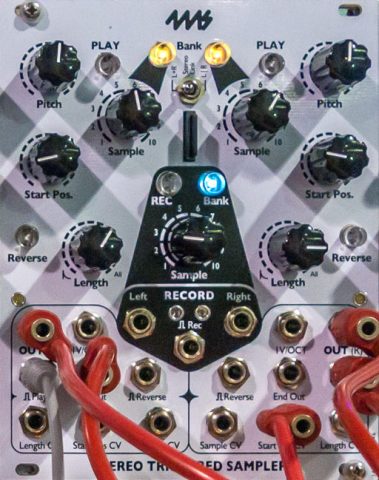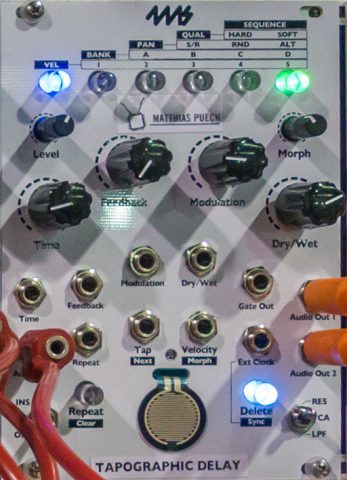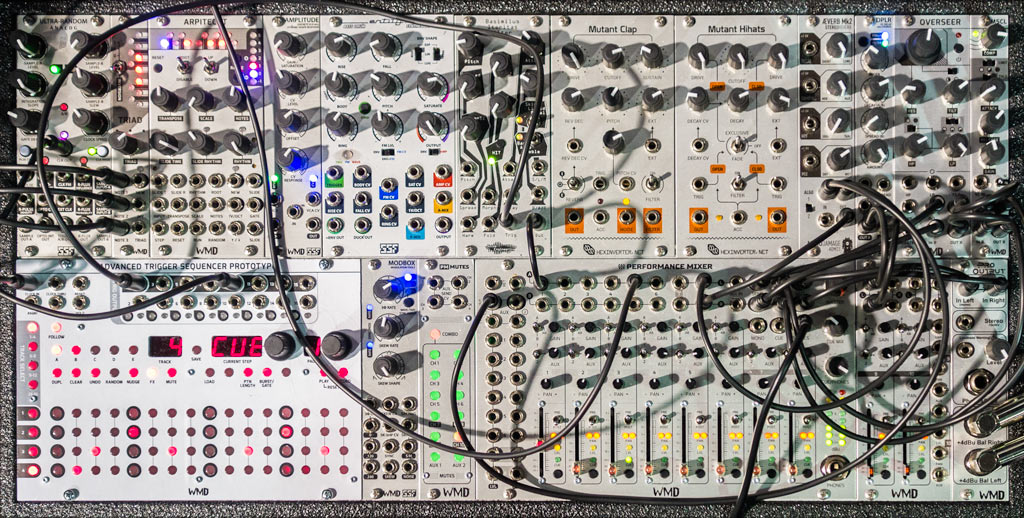After covering a few lesser-known (in the US) European modular companies in the previous installment, this time around I’m going to cover three of the better known US manufacturers. The themes running through this installment are live performance and sample manipulation.
WMD
WMD launched a boatload of new modules – most of which can be seen in the rack up top – with an overarching theme for many of making live gigging easier. Alex Anderson of WMD explained to me that he and Tyler Thompson (designer of their Aperture filter) had been doing a lot of live performing lately, developing ideas for and testing new module designs.
Two modules aimed at those with a DJ orientation are the stereo filter Overseer ($269; available in roughly 2 months) and the stereo compressor/limiter called Muscle or “MSCL” for short ($249, available in just a week or two). The stereo filter has a low pass output on the left and high pass on the right with direct outputs, as well as a Tilt control that can cross-blend the two that creates an interesting swirling effect. An effect bypass switch that kicks in on release shows the live DJ orientation of this module. MSCL is also intended as an end-of-chain device (going between the modular’s mixer and your external sound system) with relatively minimal controls and a lack of external voltage control, although it does have a sidechain mode where it can follow an external signal.
A module that really caught my attention was their Arpitecht ($299; ~1-2 months away) voltage controlled quantizer and arpeggiation generator. With this module you set the mode for the quantizer, which lights up an LED representation of a one-octave keyboard above. A Notes control then goes through a variety of different patterns of notes that are muted from this scale. The remaining notes are then arpeggiated, with control over glide, direction, rhythmic patterns, etc. It has an impressive number of voltage control and gate inputs allowing its output to be varied by a sequencer or other modulation sources. This is great for musicians who prefer some algorithmic help in generating notes rather than having to conceive each melody or arpeggiation themselves. There is also a Triad expander available ($99) with three outputs, which can generate chords out of an incoming master control voltage.
 The big toy in the room was their upcoming Advanced Trigger Sequencer ($5-600, shipping later this year). Each sequence features up to 16 rows or lines of triggers in 4 banks of 4. A sequence may be up to 8 pages of 16 steps each yielding up to 128 steps, with commands that make it easier to fill a long sequence with an initial patter of 16 steps and then program variations per page. See all those “LEDs” along the bottom half of the front panel? Those are buttons, making it easy to enter changes in those variations for each line, and graphically see the results. Even nicer is that you can program a variation and it will not take effect until you cue it, at which point it comes in on the next downbeat. There are also various modes for ratcheting, rolls, and bursts of triggers.
The big toy in the room was their upcoming Advanced Trigger Sequencer ($5-600, shipping later this year). Each sequence features up to 16 rows or lines of triggers in 4 banks of 4. A sequence may be up to 8 pages of 16 steps each yielding up to 128 steps, with commands that make it easier to fill a long sequence with an initial patter of 16 steps and then program variations per page. See all those “LEDs” along the bottom half of the front panel? Those are buttons, making it easy to enter changes in those variations for each line, and graphically see the results. Even nicer is that you can program a variation and it will not take effect until you cue it, at which point it comes in on the next downbeat. There are also various modes for ratcheting, rolls, and bursts of triggers.
A lot of companies make trigger sequencers, just like a lot of companies make mixer modules. But just as WMD hit it out of the park with their Performance Mixer, it looks like they’re going to do the same with their Advanced Trigger Sequencer. (Speaking of the Performance Mixer, WMD announced Mutes ($99) and Channels ($249) expander for it at the show.)
 But wait; there’s more! WMD was also showing a pair of modules they created in collaboration with other manufacturers. One is Flex ($199; ~2 months away from shipping) which is the first Eurorack module for Mantic Effects). It is based on their popular Flex fuzz pedal, with voltage control over nearly every parameter. Flex’s hook is that it also has a PLL oscillator inside which attempts to track the incoming sound, which is in turn used to create a parallel musical line that might track perfectly or may glitch out depending on the module’s settings and the incoming signal.
But wait; there’s more! WMD was also showing a pair of modules they created in collaboration with other manufacturers. One is Flex ($199; ~2 months away from shipping) which is the first Eurorack module for Mantic Effects). It is based on their popular Flex fuzz pedal, with voltage control over nearly every parameter. Flex’s hook is that it also has a PLL oscillator inside which attempts to track the incoming sound, which is in turn used to create a parallel musical line that might track perfectly or may glitch out depending on the module’s settings and the incoming signal.
Their other collaboration is ModBox Modulation Tools ($199, also ~2 months away) with SSF. This is a dual LFO with external clock sync. The first LFO three different phase outputs (0°, 120°, and 240°), that all are one of three different waveforms: sine, triangle, or sawtooth. The other LFO may be continuously varied between falling ramp (which makes a good percussive envelope, especially when synchronized to an external clock), triangle, and rising ramp. There’s also a sample & hold as well as a noise source inside this compact, flexible module.
4ms
I spoke with Dan Green of 4ms, who demonstrated a pair of deep sound recording & playback modules at NAMM: the Stereo Triggered Sampler and the Tapographic Delay. As I was involved with the Prophet 2000 and Studio 440 samplers back in my days at Sequential and also wrote articles about using samplers for sequenced and percussion playback, I was particularly interested in the sampler module.

Banks of sounds are loaded and played directly from the MicroSD card. Each bank can have up to 10 samples with a wide range of formats, selectable with a knob or by control voltage. The beginning of each sample is pre-loaded when a bank is selected (and the rest is streamed as needed, up to the .wav file format limit of 4 GB), allowing very fast and repeatable triggering – Dan thinks he can get inside the 1.5msec trigger in to sound out delay of the Akai S-900/950 samplers which were preferred by drummers back in the day. When you change the Start Position for a sample (again, by knob or voltage control), if it needs to buffer a new portion of the sample the trigger delay might reach as high as 20msec, but the second time you play it from that start position the delay goes back down to normal. You can also play back samples in looping or one-shot mode (as well as reversed), and change the playback length. As you get to shorter and shorter lengths, their sampler imposes a percussive instant on/exponential decay envelope onto the sound. A trigger is generated when the sample has finished playback.
LED switches change color to display which bank is currently loaded. The number of banks is limited by the size of your samples versus the size of your MicroSD card, as well as your ability to detect different shades of color produced by the LED. This was not the only module at the show which uses changing LED color to display modes. I’m a little wary of this approach as – fun fact – 4.5% of people (8% of men) are color impaired or color blind, plus colored lights on stage can change your perception of the color being displayed – but maybe I’m just being an old fart, and need to learn to give up numbers for colors in the UIs of the future.

In addition to the normal overall time and wet/dry mix controls, there’s feedback, looping or non-looping modes, and an external clock in, as well as modulation to vary the timing of the taps. You can recall four different banks for six presets, and morph between presets (anyone remember the Lexicon Vortex?).
Both modules should ship sometime this spring (hopefully before Superbooth17), with the sampler coming first. Prices are not yet set, but Dan said to expect them to be roughly around that of the 4ms Spectral Multiband Resonator ($475) or Dual Looping Delay ($415).
Make Noise

The Morphagene records and plays back stereo 48 kHz 24-bit audio. A “Reel” can contain up to 87 seconds of sound, and can be recorded directly into the module or loaded from a MicroSD card. A Reel may contain up to 99 “Splices” which can subdivide those 87 seconds in any way; an LED changes color to indicate which Splice is currently being played (see my mini-rant above about the trend of colors replacing numeric readouts for functions such as these). Splices can then be divided on the fly into “Genes” which can be as short as a few microseconds. A Gene can be thought of as zooming in on a particular portion of a Splice, with a start offset and duration as well as a Slide parameter for moving the Gene’s window of time along a Splice. An external gate signal can step between Splices; there are also End of Splice and End of Gene outputs. The Morph control then sets the playback overlap between Genes in time. For example, with Morph fully counterclockwise, there will be a small gap in playback at the end of the Gene before it plays again. According to Walker Farrell of Make Noise, with small Gene sizes this can create pointillist textures. Around 9:00 the Morph control results in a “perfect” loop where the Gene starts again at the exact moment it ends, and beyond that the next playback starts before the end of the current Gene, resulting in overlap and eventually several copies of the Gene playing all at once.
(Fun Fact: There is a text file format available for defining where the Splice start and end points fall within a Reel, but currently nothing writes it; there is hope that eventually Cycling74’s Max will. I wouldn’t mind seeing something that could also translate markers placed in apps such as Ableton Live…)
As noted above, Morphagene can record sounds as well as load them from a card; the input has an auto-leveling system that can adjust from line level to modular signal levels. There is a Varispeed control that can also play the sound in reverse, an Organize control to re-order pieces of the original sound, and regeneration (or “time lag accumulation” as described by Terry Riley). And there is voltage control over essentially every parameter.
Overall, I was impressed with the smoothness of Morphogene’s processing – for lack of words, it was far more elegant than glitchy. In very broad terms, I would say Morphagene is better at creating overall soundscapes and environments, where 4ms’s Stereo Triggered Sampler is better at musical “events” such as percussive sounds.
I’m probably going to be offline for a couple of days while I catch up with some other work, and hang out with Suit & Tie Guy while he’s in New Mexico after NAMM. More installments should appear later this week…

